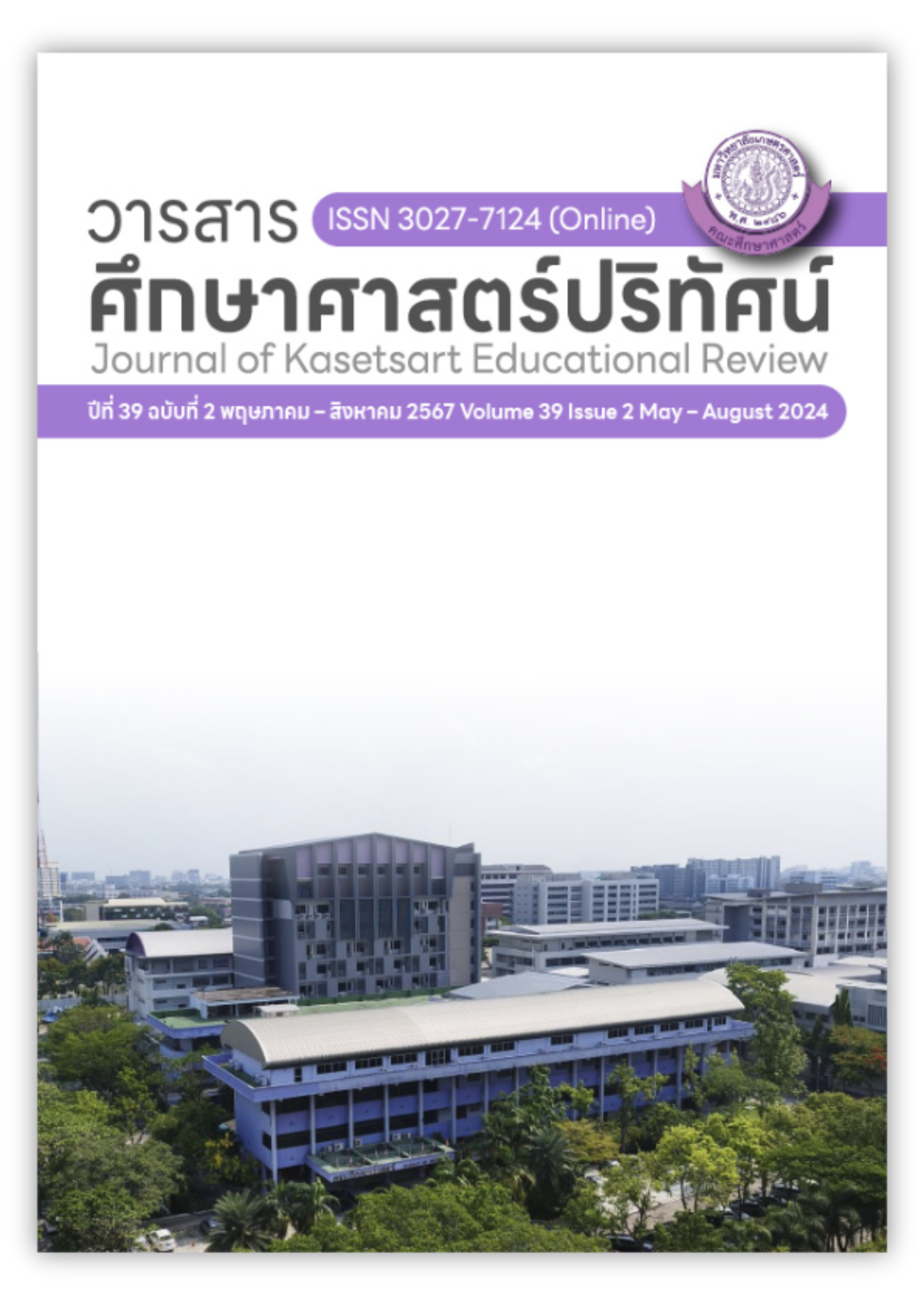การพัฒนาเครื่องประเมินการฝึกยิมนาสติก: ท่ากางเขนบนอุปกรณ์ห่วงนิ่ง
คำสำคัญ:
การฝึกยิมนาสติก, ท่ากางเขน, อุปกรณ์ประเมิน, ความแข็งแรงกล้ามเนื้อ, เซ็นเซอร์วัดแรงตึงบทคัดย่อ
การวิจัยนี้มีวัตถุประสงค์เพื่อพัฒนานวัตกรรมประเมินความก้าวหน้าการฝึกยิมนาสติกใน ท่ากางเขนบนอุปกรณ์ห่วงนิ่ง ใช้รูปแบบการวิจัยและพัฒนา เครื่องต้นแบบสร้างขึ้นตามทฤษฎีแรง
โดยวัดความแข็งแรงกล้ามเนื้อแขนทั้งสองข้างขณะออกแรงดึงห่วงลง อุปกรณ์ประกอบด้วยเซ็นเซอร์
วัดแรงตึงติดกับห่วงและกล่องควบคุม มีความละเอียดในการวัดที่ 0.01 กิโลกรัม ค่าความคลาดเคลื่อนแบบสุ่ม ±0.001 และค่าความถูกต้องที่ร้อยละ 99.58 จากนั้นทดสอบการใช้งานในนักศึกษาชายที่มีพื้นฐานยิมนาสติก จำนวน 10 คน โดยเลือกจากการสุ่มตัวอย่างแบบง่าย ผู้เข้าร่วมรับการทดสอบ 10 ครั้ง ใช้สถิติเชิงพรรณนาในการวิเคราะห์ข้อมูล และทดสอบความแตกต่างของแรงข้างซ้ายและขวาด้วยสถิติ Wilcoxon Signed Ranks Test ที่ระดับนัยสำคัญ .05
ผลการศึกษาพบว่าอุปกรณ์สามารถตรวจจับความแปรผันของแรงแขนตามระดับความแข็งแรงของแต่ละบุคคล ซึ่งไม่มีความแตกต่างกันทางสถิติ ค่าสัมประสิทธิการกระจายอยู่ในช่วงร้อยละ 3.38 – 47.09 ค่าเฉลี่ยที่ร้อยละ 16.36±9.32 ซึ่งมีความแปรปรวนในระดับปานกลาง เมื่อทดสอบความต่างของสัมประสิทธิการกระจายทั้งข้างซ้ายและขวาไม่แตกต่างกัน โดยสรุปอุปกรณ์นี้วัดแรงของแขนทั้งสองข้างได้อย่างมีประสิทธิภาพ ทำให้เหมาะสมกับการประเมินความแข็งแรงของกล้ามเนื้อ ความสมดุลแรงแขน และประเมินความก้าวหน้าในการฝึกยิมนาสติกท่ากางเขนบนอุปกรณ์ห่วงได้ ในการพัฒนาอุปกรณ์นี้สามารถปรับปรุงการแสดงผลเพื่อประมวลความสมดุลและการออกแรงตามน้ำหนักผู้ใช้ นอกจากนี้การใช้ระบบไร้สาย และแสดงข้อมูลออนไลน์พร้อมการดูย้อนหลังจะช่วยเพิ่มความทนทานและความสะดวกแก่ผู้ใช้งาน
เอกสารอ้างอิง
Aronhime, S., Calcagno, C., Jajamovich, G. H., Dyvorne, H. A., Robson, P., Dieterich, D., ... & Taouli, B. (2014). DCE‐MRI of the liver: effect of linear and nonlinear conversions on hepatic perfusion quantification and reproducibility. Journal of Magnetic Resonance Imaging, 40(1). 90-98.
Bernasconi S., Tordi N., Parratte B., Rouillon JD., & Monnier G. (2004). Surface electromyography of nine shoulder muscles in two iron cross conditions in gymnastics. Journal of Sport Medicine et Physical Fitness, 44(3). 240-245.
Carrara, P. D. S. (2015). Biomechanical analysis of the cross on rings in gymnastics (Doctoral dissertation, Universidade de São Paulo). https://teses.usp.br/teses/disponiveis/39/39132/tde-19112015-162202/publico/Paulo_Daniel_Sabino_Carrara_corrigida.pdf
Dordevic D., Paunovic M., Velickovic S., Velickovic P., Stankovic M., Radanovic D., Mujanovic R., Mujanovic D., Jelaska I., Pezelj L., & Sporis D. (2023). Technical elements on the rings in men’s artistic gymnastics--a systematic review. Journal of Men’s Health, 19(10). 7-15.
Dunlavy, J. K., Sanda, W.A., McNeal, J. R., Stone, M.H., Smith, S.L., Jemni, M., & Haff, G.G. (2007). Strength performance assessment in a simulated men’s gymnastics still rings cross. Journal of Sports Science and Medicine, 6. 93-97.
Fédération Internationale de Gymnastique. (2020). 2022-2024 Code of Points: Men’s artistic gymnastics. https://gymnasticsresults.com/technical/code-of-points/2022-2024-mag-cop.pdf
Halliday, D., Resnick, R., & Walker, J. (2013). Fundamentals of Physics (10th ed.). John Wiley & Sons.
Kane, M. T. (1992). Validating the performance of tests. Educational Measurement: Issues and Practice, 11(4), 5-17.
Kumar, A., & Kushreshtha, D. C. (2015). Engineering Machanics: Statics and Dynamics. Jaypee University of Information Technology, Solan, HP.
Sands, W.A., Dunlavy, J.K., Smith, S.L., Stone, M.H. & McNeal, J.R. (2006) Understanding and training the Maltese. Technique, 26(5). 6-9.
Taylor, J. R. (1997). An introduction to error analysis: The study of uncertainties in physical measurements (2nd ed.). Sausalito, CA: University Science Books.
ดาวน์โหลด
เผยแพร่แล้ว
ฉบับ
ประเภทบทความ
สัญญาอนุญาต
ลิขสิทธิ์ (c) 2024 วารสารศึกษาศาสตร์ปริทัศน์

อนุญาตภายใต้เงื่อนไข Creative Commons Attribution-NonCommercial-NoDerivatives 4.0 International License.
บทความทุกบทความเป็นลิขสิทธิ์ของวารสารคณะศึกษาศาสตร์ มหาวิทยาลัยเกษตรศาสตร์ วิทยาเขตบางเขน
วารสารศึกษาศาสตร์ปริทัศน์ (Kasetsart Educational Review)






